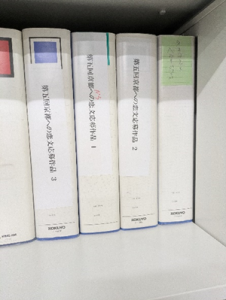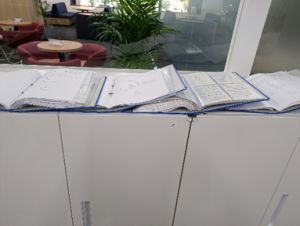Is the “address of the heart” Kyo-Suzume Ward, Kyoto City?
Yoshie Doi
 |
 |
Files on the bookshelf of Kyo-Suzume’s “Love Letter to Kyoto” (photographed on July 8, 2024)
I read the submissions for the 5th Kyoto Love Letters Contest many times. Every time I read them, I was moved by something new. I thought of the people who submitted them, savored the stories, and read them so enthusiastically that I lost track of time.
I’m sure the judges and the general public felt the same way. There were many entries that were full of love, with many sharing their memories of Kyoto, their expectations for Kyoto, what they learned from Kyoto’s profound history and culture, and how they wanted to show people around Kyoto. There were many powerful entries that spoke of life itself.
All of the works submitted from all over Japan, from Kyushu to Hokkaido, were written with deep emotion. Although their residential addresses vary, the works are written by people who love Kyoto so much that it makes you think that their “heart’s address” is Kyo-Suzume Ward, Kyoto City. I was filled with gratitude to be able to live in such an amazing city, with so many people who admire and talk about their feelings for the city. Thank you, Kyoto! Thank you! I said to them in thanks.
The submitted works allowed us to rediscover the hidden beauty and splendor of Kyoto, a city that took a thousand years to build. Thank you very much.
With the recent revival of inbound tourism, the number of tourists has increased. The newspapers translate overtourism as “tourism pollution,” but this is a disrespectful term to tourists. I don’t think it should be used in a city whose economy is thriving on tourism. This is because there is no love behind the term “pollution,” which pits perpetrators and victims against each other. It is on a different level from the term used in Kyoto, an international tourist city.
The April 24, 2024 edition of the Kyoto Shimbun translated overtourism as excessive tourism. I think this is the meaning of the global term. For Kyoto, overtourism is an opportunity.
However, the current situation is that government policies and responses have not kept up. This is because there is little awareness of the opportunity that overtourism can bring.
Japan’s inbound spending from January to March 2024 will be 7.2 trillion yen on an annualized basis. This is five times the amount from ten years ago. No other industry has increased five-fold in ten years. It has grown by 38.8% since before the COVID-19 pandemic (2019). There is no other industry like it in the world. Japan is growing by leaps and bounds. Japan is the only country to have grown by nearly 40%! Even semiconductors, which are growing, are at 5.5 trillion yen. I don’t think it’s an industry that can be compared, but even the semiconductor industry, which is growing, is at 5.5 trillion yen, with a growth rate of 40%. In second place is Spain with 30.7%, and in third place is Italy with 16.5%. Japan’s weak yen also makes it an easy place to visit.
The number of foreign visitors to Japan in April 2024 is expected to reach 3,042,900, up 56.1% from the same month last year, a significant increase (JNTO estimate updated June 12).
With the inbound tourism growth rate at 60%, I think it is time for citizens and the government to think more seriously about bottom-up welcoming policies together.
Number of tourists in 2022:
Kyoto City 43,612,000
Kyoto Prefecture 71,284,631
When citizens consider how to balance the government’s goal of “60 million inbound tourists and 15 trillion yen in revenue by 2030” with the lives of residents, and try to find a compromise, I think that inbound tourism is an opportunity to feel Kyoto’s absolute difference (an insurmountable difference). The reason why people ring shrine bells too loudly is because this culture does not exist. What should be taken for granted is not so.
By communicating the current state of Kyoto, we hope to awaken the DNA of the Japanese people and create opportunities to experience a culture of gratitude for nature, a love for Kyoto that can only be described as falling in love with Kyoto, and the source of the Japanese spirit.
The end of document
Translated by Masami Otani
